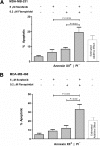Flavopiridol synergizes with sorafenib to induce cytotoxicity and potentiate antitumorigenic activity in EGFR/HER-2 and mutant RAS/RAF breast cancer model systems
- PMID: 23908594
- PMCID: PMC3730045
- DOI: 10.1593/neo.13804
Flavopiridol synergizes with sorafenib to induce cytotoxicity and potentiate antitumorigenic activity in EGFR/HER-2 and mutant RAS/RAF breast cancer model systems
Abstract
Oncogenic receptor tyrosine kinase (RTK) signaling through the Ras-Raf-Mek-Erk (Ras-MAPK) pathway is implicated in a wide array of carcinomas, including those of the breast. The cyclin-dependent kinases (CDKs) are implicated in regulating proliferative and survival signaling downstream of this pathway. Here, we show that CDK inhibitors exhibit an order of magnitude greater cytotoxic potency than a suite of inhibitors targeting RTK and Ras-MAPK signaling in cell lines representative of clinically recognized breast cancer (BC) subtypes. Drug combination studies show that the pan-CDK inhibitor, flavopiridol (FPD), synergistically potentiated cytotoxicity induced by the Raf inhibitor, sorafenib (SFN). This synergy was most pronounced at sub-EC50 SFN concentrations in MDA-MB-231 (KRAS-G13D and BRAF-G464V mutations), MDA-MB-468 [epidermal growth factor receptor (EGFR) overexpression], and SKBR3 [ErbB2/EGFR2 (HER-2) overexpression] cells but not in hormone-dependent MCF-7 and T47D cells. Potentiation of SFN cytotoxicity by FPD correlated with enhanced apoptosis, suppression of retinoblastoma (Rb) signaling, and reduced Mcl-1 expression. SFN and FPD were also tested in an MDA-MB-231 mammary fat pad engraftment model of tumorigenesis. Mice treated with both drugs exhibited reduced primary tumor growth rates and metastatic tumor load in the lungs compared to treatment with either drug alone, and this correlated with greater reductions in Rb signaling and Mcl-1 expression in resected tumors. These findings support the development of CDK and Raf co-targeting strategies in EGFR/HER-2-overexpressing or RAS/RAF mutant BCs.
Figures







Similar articles
-
Fisetin, a phytochemical, potentiates sorafenib-induced apoptosis and abrogates tumor growth in athymic nude mice implanted with BRAF-mutated melanoma cells.Oncotarget. 2015 Sep 29;6(29):28296-311. doi: 10.18632/oncotarget.5064. Oncotarget. 2015. PMID: 26299806 Free PMC article.
-
Fisetin, a dietary flavonoid, augments the anti-invasive and anti-metastatic potential of sorafenib in melanoma.Oncotarget. 2016 Jan 12;7(2):1227-41. doi: 10.18632/oncotarget.6237. Oncotarget. 2016. PMID: 26517521 Free PMC article.
-
RETRACTED ARTICLE: Investigating EGFR-VEGF-mediated apoptotic effect of cucurbitacin D and I combination with sorafenib via Ras/Raf/MEK/ERK and PI3K/Akt signaling pathways.Naunyn Schmiedebergs Arch Pharmacol. 2024 May;397(5):3247. doi: 10.1007/s00210-023-02811-z. Epub 2023 Nov 2. Naunyn Schmiedebergs Arch Pharmacol. 2024. PMID: 37917368 Retracted. No abstract available.
-
Review of flavopiridol, a cyclin-dependent kinase inhibitor, as breast cancer therapy.Semin Oncol. 2002 Jun;29(3 Suppl 11):77-85. doi: 10.1053/sonc.2002.34059. Semin Oncol. 2002. PMID: 12138401 Review.
-
The Ras/MAPK pathway and hepatocarcinoma: pathogenesis and therapeutic implications.Eur J Clin Invest. 2015 Jun;45(6):609-23. doi: 10.1111/eci.12441. Epub 2015 May 11. Eur J Clin Invest. 2015. PMID: 25832714 Review.
Cited by
-
Activation of CDK4 Triggers Development of Non-alcoholic Fatty Liver Disease.Cell Rep. 2016 Jul 19;16(3):744-56. doi: 10.1016/j.celrep.2016.06.019. Epub 2016 Jun 30. Cell Rep. 2016. PMID: 27373160 Free PMC article.
-
CDK/CCN and CDKI alterations for cancer prognosis and therapeutic predictivity.Biomed Res Int. 2014;2014:361020. doi: 10.1155/2014/361020. Epub 2014 Jan 29. Biomed Res Int. 2014. PMID: 24605326 Free PMC article. Review.
-
A Versatile Cell Death Screening Assay Using Dye-Stained Cells and Multivariate Image Analysis.Assay Drug Dev Technol. 2015 Nov;13(9):547-57. doi: 10.1089/adt.2015.661. Epub 2015 Sep 30. Assay Drug Dev Technol. 2015. PMID: 26422066 Free PMC article.
-
Cyclin-dependent kinase 11(p110) (CDK11(p110)) is crucial for human breast cancer cell proliferation and growth.Sci Rep. 2015 May 20;5:10433. doi: 10.1038/srep10433. Sci Rep. 2015. PMID: 25990212 Free PMC article.
-
Sorafenib improves alkylating therapy by blocking induced inflammation, invasion and angiogenesis in breast cancer cells.Cancer Lett. 2018 Jul 1;425:101-115. doi: 10.1016/j.canlet.2018.03.037. Epub 2018 Mar 30. Cancer Lett. 2018. PMID: 29608984 Free PMC article.
References
-
- Rusnak DW, Alligood KJ, Mullin RJ, Spehar GM, Arenas-Elliott C, Martin AM, Degenhardt Y, Rudolph SK, Haws TF, Jr, Hudson-Curtis BL, et al. Assessment of epidermal growth factor receptor (EGFR, ErbB1) and HER2 (ErbB2) protein expression levels and response to lapatinib (Tykerb, GW572016) in an expanded panel of human normal and tumour cell lines. Cell Prolif. 2007;40:580–594. - PMC - PubMed
-
- Pegram MD, Konecny GE, O'Callaghan C, Beryt M, Pietras R, Slamon DJ. Rational combinations of trastuzumab with chemotherapeutic drugs used in the treatment of breast cancer. J Natl Cancer Inst. 2004;96:739–749. - PubMed
-
- Slamon DJ, Godolphin W, Jones LA, Holt JA, Wong SG, Keith DE, Levin WJ, Stuart SG, Udove J, Ullrich A, et al. Studies of the HER-2/neu protooncogene in human breast and ovarian cancer. Science. 1989;244:707–712. - PubMed
-
- Janne PA, Gray N, Settleman J. Factors underlying sensitivity of cancers to small-molecule kinase inhibitors. Nat Rev Drug Discov. 2009;8:709–723. - PubMed
Publication types
MeSH terms
Substances
Grants and funding
LinkOut - more resources
Full Text Sources
Other Literature Sources
Medical
Research Materials
Miscellaneous
